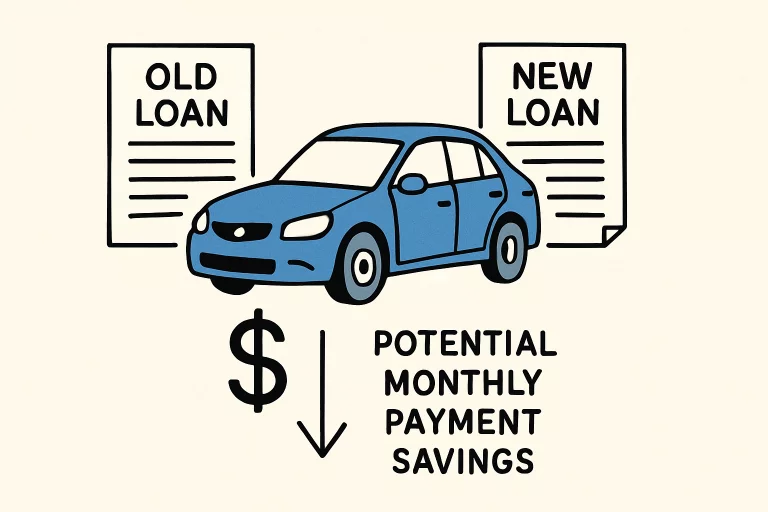For most households, managing monthly expenses is a crucial part of staying financially healthy, and the monthly car payment is often one of the most significant contributors to ongoing financial obligations. Car loan refinancing can be an innovative financial solution if you’re looking for ways to control your budget, increase savings, or make more room in your cash flow.
Replacing your current car loan with a new one—typically featuring a different interest rate, loan length, or payment amount—could reap substantial benefits in immediate and long-term monetary savings. Exploring your options with reliable platforms like iLending allows you to see personalized possibilities and better understand how refinancing might work for your situation.
This article provides a comprehensive overview of car loan refinancing, detailing its impact on monthly payments and the potential to lower obligations, shorten loan terms, or secure favorable interest rates. It emphasizes the importance of understanding the process, weighing factors, and aligning the choice with overall financial goals to ensure the best economic outcome.
What Is Car Loan Refinancing?
Car loan refinancing is the process of obtaining a new auto loan to pay off and replace your current car loan, almost always with a different lender and often under improved terms. The new lender pays the balance remaining on your original loan, allowing you to start paying off the new loan as agreed. People often seek refinancing for one or more reasons: to secure a lower interest rate based on improved credit, to consolidate debt, to extend or shorten their repayment period, or to lower their monthly payments to better fit changes in their living expenses. Refinancing can also be helpful if your previous loan was less competitive or market interest rates have dropped since you first purchased your vehicle.
This option is especially appealing for individuals who have seen their credit scores improve significantly since first taking out their auto loan, as even a modest increase in credit rating can unlock more favorable interest rates. Additionally, when overall interest rates fall, borrowers can use refinancing to lock in lower monthly costs. Tools like the car loan refinance calculators on the Consumer Financial Protection Bureau website help estimate how your monthly payment, total interest paid, and other loan details could change after refinancing. Assessing these variables up front can ensure you make an educated decision that best serves.

How Refinancing Affects Monthly Payments
The most popular reason borrowers opt for car loan refinancing is to reduce their monthly payments, thus easing their regular financial burden. Several essential factors directly impact how much you’ll pay each month after refinancing:
- Lower Interest Rate: If you qualify for a significantly lower interest rate, your monthly payments will generally decrease, sometimes by a noteworthy amount. Your monthly payments become more affordable, and you can save hundreds or even thousands of dollars throughout your new loan. Lower interest rates directly translate to less money paid in finance charges, enabling you to put more of your payment toward your principal balance or redirect the savings elsewhere in your budget.
- Extended Loan Term: Enabling your repayment period over months or years furthers your payments, meaning you pay less each month. This can create valuable breathing room in your monthly spending, especially in tight financial periods. However, it’s essential to remember that lengthening your loan typically increases the total amount of interest paid over the life of the loan, as the lender has longer to collect interest charges, even if each payment is less.
- Shorter Loan Term: Refinancing into a loan with a shorter term will likely result in higher monthly payments, but it will enable you to pay off the loan much sooner and pay less interest overall. This option is best for those whose financial situation has improved and who can now handle higher monthly payments, to be debt-free faster and save on interest charges.
Factors to Consider Before Refinancing
While refinancing can offer substantial benefits, it isn’t the perfect solution for everyone. It’s essential to carefully assess several key factors to determine whether refinancing aligns with your personal financial goals:
- Credit Score: The terms and rates you offer depend heavily on your credit profile. Refinancing can unlock better rates and savings opportunities if your score has increased since you took out your original loan. However, if your credit has declined, refinancing may offer limited benefits and even potentially result in higher costs in some cases.
- Loan-to-Value Ratio (LTV): Lenders evaluate risk by comparing how much money you owe on the loan to the current market value of your car. A lower LTV ratio means less risk, which may help you secure better rates and terms. If your vehicle has lost value or you have little equity, your refinancing options could be restricted or less appealing.
- Current Interest Rates: Always compare prevailing market rates to the rate you’re currently paying. If there’s a substantial difference and rates have generally dropped, you’re more likely to benefit from a refinance. Conversely, refinancing when rates are the same or higher usually isn’t advantageous.
- Fees and Penalties: Be sure to check your current loan’s terms for any prepayment penalties. Also, consider new loan costs like lender origination fees, title transfer charges, or local taxes, as these can quickly erode or negate your anticipated savings from refinancing.
Steps to Refinance Your Car Loan
- Review Your Current Loan: Gather documents related to your existing car loan. Understand your balance, interest rate, remaining term, and any fees or restrictions that may apply to early payoff. This helps you establish a clear baseline for comparison.
- Check Your Credit Score: Request a copy of your latest credit report from one or more credit bureaus. You should check your score and review the entire report for errors or outdated information that could be corrected to help you secure a better rate.
- Research and Compare Lenders: Invest time in looking at various refinance options. Direct lenders, credit unions, online loan marketplaces, and specialty auto refinance providers can offer vastly different rates and terms. It’s essential to gather multiple offers to compare them and make an informed decision. Use refinancing calculators to compare scenarios. Analyzing your new potential monthly payment, projected total interest paid, and overall loan cost ensures you aren’t focusing only on the short term but on the proper financing.
- Apply and Close: After choosing the lender with the most favorable terms, complete the application process. Upon approval, the new lender will pay off your old loan directly, and you’ll start making payments under the new, agreed-upon terms. Confirm that your previous loan is fully closed and that your title, if required, is properly transferred.
Potential Drawbacks of Refinancing
- Higher Total Interest: Extending your loan’s repayment period to achieve lower monthly payments may cost you more over the loan’s lifetime. Even with a lower rate, the longer you take to pay it back, the more you tend to pay in total interest, reducing your overall savings.
- Fees and Upfront Costs: Refinancing is not cost-free. Potential fees can include application charges, lender origination fees, state taxes, and other title or paperwork costs, reducing or eliminating your refinance savings if not carefully tallied beforehand.
- Impact on Credit Score: Applying for a refi loan creates a hard inquiry on your credit, which may result in a brief dip in your score. While typically short-lived, multiple credit inquiries from shopping around can have a more noticeable, albeit temporary, impact.
When to Avoid Refinancing
- Almost Paid Off: If your current loan only has a few payments left, any interest savings from refinancing will likely be negligible. In this situation, completing the application process after applying for the loan is usually more sensible.
- High Prepayment Penalties for paying off a loan early. Always examine your original loan agreement; high prepayment penalties could counteract any benefit you’d receive from a refinance.
- Negative Equity: When you owe more on your car than it’s worth (being “upside-down”), refinancing can be complicated and usually isn’t cost-effective. Lenders may not be willing to offer favorable terms, and you could end up owing more or being locked into less advantageous terms.
Conclusion
Car loan refinancing is a powerful financial tool for those who want greater flexibility in their monthly budget or have the potential to reduce the overall cost of their auto loan. However, not every borrower will benefit the same way, so it’s crucial to assess your current loan, compare offers, factor in your credit position, and take into account any fees that may be involved.
The best refinancing decisions stem from balancing your immediate need for lower payments against your long-term cost and savings goals. For a tailored assessment of your refinancing options and guidance specific to your circumstances, visit iLending and get started on reclaiming control of your auto finance future.
